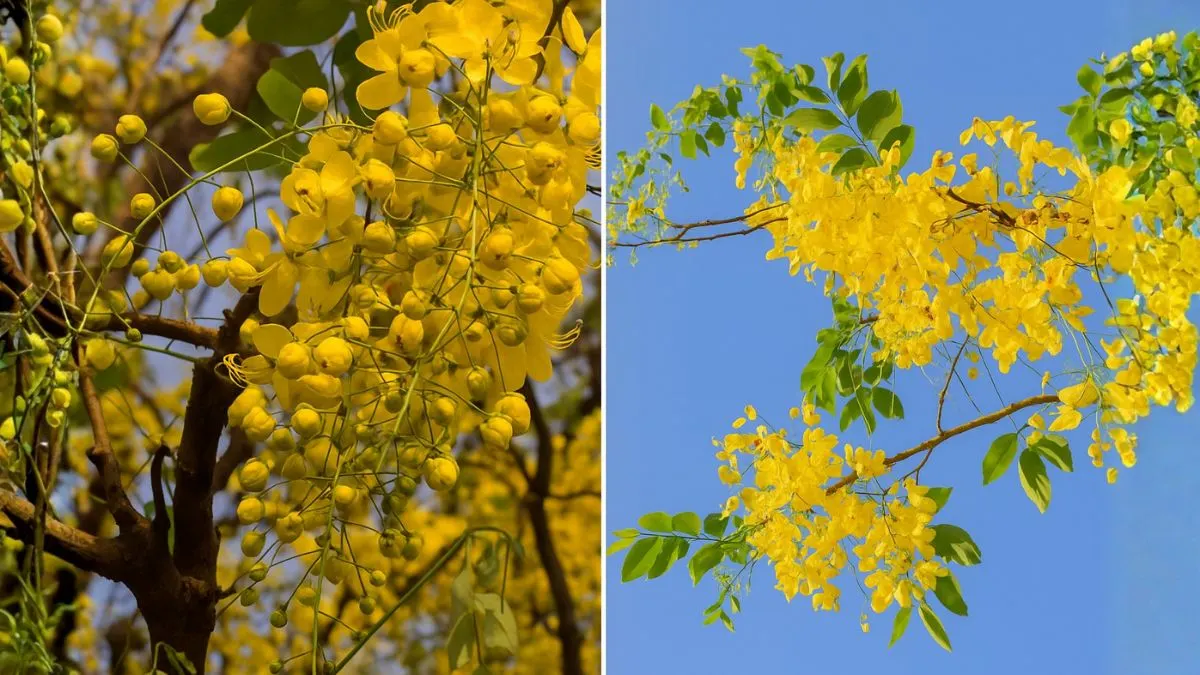There are few sights in nature as striking as a Golden Shower Tree in full bloom. Known locally as Amaltas and scientifically as Cassia fistula, this tree is one of the most celebrated symbols of tropical beauty. Its drooping clusters of bright yellow flowers light up streets, gardens, and temples, especially in late spring and early summer, creating a canopy of gold.
But the Amaltas Tree isn’t just about looks. It plays a vital role in apiculture, serves as a traditional medicinal plant, and carries deep cultural significance across Asia. In this blog, we’ll explore the story of Cassia fistula, its characteristics, uses, and why it continues to enchant gardeners and nature lovers across the globe, including Canada and the USA.
Cassia fistula: The Golden Beauty

Botanical Profile
- Scientific Name: Cassia fistula
- Common Names: Golden Shower Tree, Amaltas
- Type: A deciduous tree native to the Indian subcontinent
- Size: Small to medium-sized tree, usually 10–20 meters tall
- Leaves: Compound, dark green, and glossy
- Flowers: Drooping clusters of golden-yellow blooms, appearing in late spring
The tree’s dense, rounded foliage provides shade, while its blooms offer an unmatched visual treat. When in full bloom, it looks like liquid sunlight cascading down branches.
Also Read: Redbud Trees Are Nature’s Pink Fireworks—Here’s How to Grow Them
Cultural and Mythological Significance
The Golden Shower Tree is deeply rooted in cultural traditions. In India and Southeast Asia, it is considered sacred and is often associated with festivals and rituals.
- In Kerala, India, the tree is linked to the Vishu festival, marking the traditional New Year.
- In Thailand, it is the national tree, symbolizing prosperity and unity.
- Mythologically, Cassia fistula is like the wise old sage, offering guidance and healing, reminding us of nature’s wisdom and resilience.
Role in Apiculture
Did you know? The tree is very useful in Apiculture. Its blooms are a nectar haven for honeybees.
- Beekeepers often plant Amaltas near apiaries.
- The yellow flowers attract pollinators, boosting honey production.
- This makes the tree not only beautiful but also practical for sustainable farming.
Medicinal Uses
Traditional medicine has long recognized the healing powers of Cassia fistula.
- Pods and pulp: Used as natural laxatives.
- Flowers and bark: Believed to reduce inflammation and treat skin conditions.
- Ayurveda: Reveres Amaltas for its cooling and purifying qualities.
In many cultures, the tree is considered a guardian healer, balancing beauty with functionality.
Also Read: Grow These 7 Edible Plants in Just Water—No Soil, No Mess!
Growing Cassia fistula in Your Garden
1. Choosing the Right Spot
The Amaltas Tree, also known as the Golden Shower Tree, thrives in full sunlight.
- Plant it in open areas where it can spread freely.
- It adapts well to tropical and subtropical climates.
- In Canada and the USA, it grows best in warmer southern regions or in botanical gardens with controlled environments.
2. Soil & Watering
- Prefers well-drained soil.
- Moderate watering is enough once established.
- It tolerates dry conditions but flourishes in monsoon-like climates.
3. Seasonal Care
- Sow seeds or saplings in spring.
- Expect flowers in late spring or early summer.
- Prune lightly to maintain structure.
Also Read: Midnight Bloomers: The Secret Flowers That Awaken in the Dark
Practical Uses Beyond Beauty
Feature |
Benefit |
Shade Provider |
Ideal for roadsides and gardens |
Apiculture |
Supports honeybee populations |
Medicinal Value |
Traditional remedies for digestion and skin |
Cultural Symbol |
Associated with festivals and rituals |
Landscape Design |
Adds dramatic golden color |
Personal Experience
When I first encountered a Cassia fistula in full bloom during a summer trip to Jaipur, it was unforgettable. The tree stood like a golden chandelier against the blue sky. What fascinated me most was how locals revered it—not just for its beauty but also for its usefulness in medicine and farming. Later, I saw it in botanical gardens in the USA, where it stood as a reminder of tropical heritage, attracting both gardeners and pollinators.
How the Golden Shower Tree Connects the World
Though native to the Indian subcontinent, the tree has found admirers across continents. In Canada and the USA, it is often featured in botanical collections, symbolizing exotic beauty. Its ability to attract pollinators and inspire awe makes it a bridge between cultures, reminding us of nature’s universality.
Conclusion
The Amaltas Tree, also known as the Golden Shower Tree or Cassia fistula, is not just another ornamental tree. It is a deciduous tree native to the Indian subcontinent, a beacon of cultural heritage, a contributor to apiculture, and a source of healing in traditional medicine. With its drooping clusters of bright yellow flowers, it adds magic to landscapes worldwide.
Like a wise old sage, Cassia fistula whispers lessons of resilience, beauty, and balance. If you’re looking to add a tree that combines aesthetics with purpose, the Golden Shower Tree deserves a place in your story.






